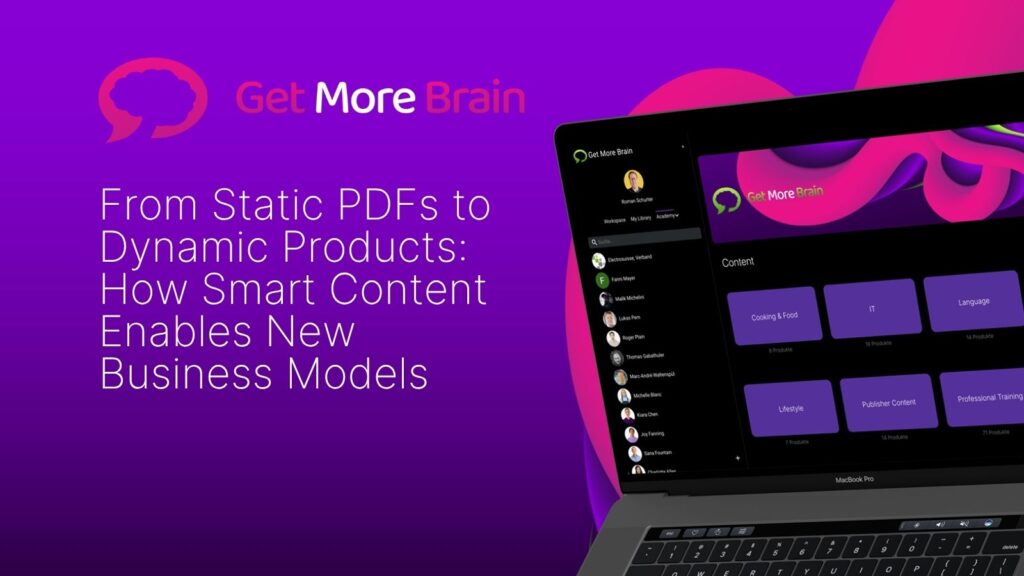From Static PDFs to Dynamic Products: How Smart Content Enables New Business Models
- Roman Schurter

Table of Contents
PDFs are ubiquitous in the publishing world. Nearly three decades after their introduction in the early 1990s, they continue to dominate the digital document landscape. But what was once revolutionary is increasingly becoming an obstacle to true digital transformation.
When Adobe developed the “Portable Document Format,” it solved a critical problem: reliable format fidelity across different platforms. No wonder professional publishers, associations, and standards organizations adopted PDFs so quickly. The advantages are obvious: format stability, easy creation, security through encryption, and compact file size.
Despite these strengths, we are increasingly reaching the limits of this format today. PDFs are fundamentally static images – conceived for a world where digital content should emulate printed documents. In an era of intelligent, networked, and adaptive systems, PDFs lack the crucial dimension: they cannot “think along.”
The Dimensional Shift: From Static to Intelligent Content
What does this mean specifically? PDFs are flat images without semantic depth. They are difficult to integrate into modern systems, offer poor accessibility on mobile devices, and resist flexible content reuse. A particularly serious problem for Standards Development Organizations (SDOs): PDFs are not machine-readable and cannot function as part of an API ecosystem.
These limitations are becoming a real competitive disadvantage in an era where content is increasingly understood as a service. Publishers who provide their content exclusively as PDFs are missing enormous potential for monetization and user retention.
From File Format to Living Content
The paradigm shift we are driving at Get More Brain addresses exactly this: With bitmark technology, we offer a fundamentally different approach. Structure takes precedence over layout; semantic meaning of content over visual consistency.
Bitmark structures content into “bits” – atomic, semantically defined units. This architecture enables for the first time what was unthinkable with PDFs:
- Content becomes platform-independent and can be optimally displayed on any device
- True interactivity becomes an integral part of the content itself
- Content can be reused modularly, recombined, and personalized
- Content can be integrated into other systems via APIs
- AI interactions with content become context-related and precise
This transformation goes far beyond a technical upgrade – it enables entirely new business models for publishers and creates added value for users.
From Publication to Product
Let’s imagine a specialized publisher who has primarily sold its content as PDF downloads. Switching to a structured, modular format like bitmark suddenly opens up new dimensions for this publisher:
- They can offer subscription models with regular updates
- Granular access for different user groups becomes possible
- Interactive elements increase utility and retention
- Measurable user behavior enables data-driven product improvements
- API access for corporate customers creates new B2B business areas
What began as a document format becomes a living product – with correspondingly higher value for all involved.
The Four Dimensions of Content Transformation
This transformation from static documents to dynamic digital products is not just a theoretical concept – it’s already happening across industries. Specialized publishers, professional associations, and standards organizations are rapidly embracing intelligent, networked content solutions that create measurable value.
What makes this shift so powerful is the multidimensional nature of the change: content becomes modular and adaptable, enabling new business models; interactive elements dramatically increase engagement; user-centered design principles drive adoption; and AI integration brings content to life in ways previously impossible.
The journey from document file to digital product may be challenging – but it opens up entirely new perspectives for growth and relevance in an increasingly digitalized world for publishers. The evidence is clear: PDF was yesterday. The future belongs to intelligent, networked, and adaptive content that creates real added value.


